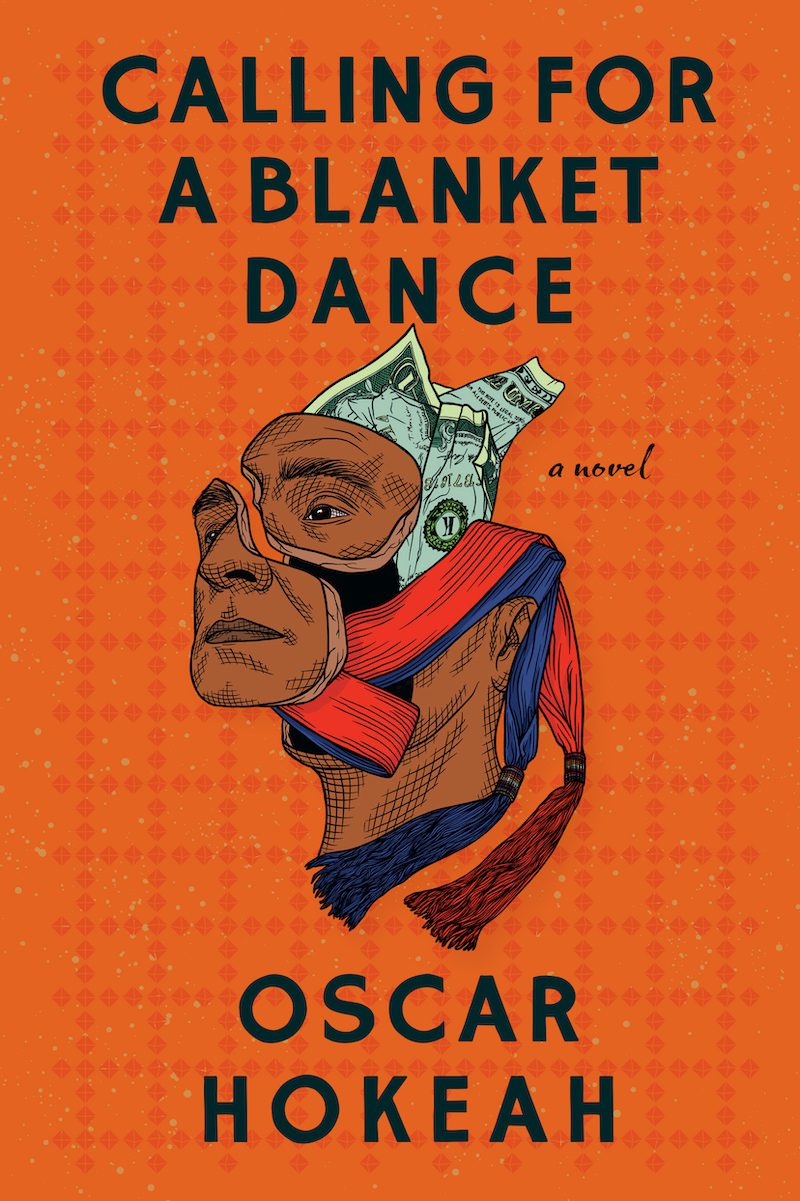We are thrilled to bring you this exclusive first look at the cover of Oscar Hokeah’s debut novel, Calling for a Blanket Dance, forthcoming from Algonquin Books on July 26, 2022.
Told in a series of voices, Calling for a Blanket Dance takes us into the life of Ever Geimausaddle through the multigenerational perspectives of his family as they soldier through a myriad of difficulties: his father’s sudden kidney failure and subsequent disability, his mother’s struggle to hold on to her job and care for her husband, the constant resettlement of the family, and Ever’s own bottled-up rage at the instability all around him. Meanwhile, all of Ever’s relatives have ideas about who he is and who he should be. His Cherokee grandmother urges the family to move across the state to find security; his dying grandfather hopes to reunite him with his heritage through traditional gourd dances; his Kiowa cousin reminds him that he’s connected to an ancestral past. And once an adult, Ever must take the strength given to him by his relatives to save not only himself, but also the next generation of family.
How will this young man visualize a place for himself when the world hasn’t given him a place to start with? Honest, heartbreaking, and ultimately uplifting, Calling for a Blanket Dance is the story of how Ever Geimausaddle found his way to home.
Below, Oscar Hokeah shares his thoughts on Calling for a Blanket Dance’s cover. Then, illustrator Christin Apodaca offers us a glimpse at how the cover came to be.
***
Oscar Hokeah on the cover art for Calling for a Blanket Dance (Algonquin Books, 7/26/22):
Before I was introduced to Christin Apodaca I’ve always had a special interest in surrealism as an art form. Whether it be in literature, like Márquez and Kafka, or in the studio arts, like the well-known Spanish artist Salvador Dalí. It was a bit of divine intervention to suddenly have the opportunity for my debut novel’s cover to reflect those similar interests. It shouldn’t have surprised me because the novel itself is very postmodern in its structure and form, which was why it made sense when Algonquin’s creative director, Christopher Moisan, introduced me to Christin’s artwork.
Instantly, I was struck by Apodaca’s three-dimensional designs. I filtered through her Instagram and her website and was in awe of both the symmetry and the abstractions. She knew exactly how to disrupt the order of the line and maintain flow, making images both alluring and jarring. It made me think of the Buddhist influences on American poetry, where the disruption was an opportunity for growth, enlightenment, engagement, awakening. Christin created fissures in my mind that I could then fill with a new way of interpreting the world. It truly captivated me. It took little to no time for me to jump back onto my emails and quickly shoot a message across cyberspace with a resounding, “Yes!” Apodaca was the perfect fit!
I waited in anticipation. Here was this amazing artist in El Paso, Texas dreaming of an interpretation of my debut novel, Calling for a Blanket Dance. When I finally received the email from Christopher, I couldn’t wait to open it. In fact, I swiped the notification right away. It hit me. I paused. Like with Christin’s other pieces of art, I had to stare at it for a moment. It was doing something to me, working on my mind, telling me to look at the world differently. The raised face split in half spoke to me of fracture and healing—the dichotomy of light and dark. The dollar bill was crumpled in the same way that we Kiowa and Comanche crumple our bills during honoring songs. And it sat inside the image’s head. It made me ask, What is in the deepest reaches of the main character’s mind? Then there is the gourd dance sash streaming out from inside the image’s face, and twisting around to land almost like double braids. It was perfectly drawn and captured our traditional sashes well. The entirety of the art piece left me reaching for answers in deep psychological and almost dreamlike spaces.
Christin was able to pull out the subconscious of the novel’s main character, Ever Geimausaddle, who faces a myriad of obstacles which threaten to fracture his identity, but through the healing power of culture, family, and community he overcomes with an identity of perseverance. Apodaca comes from a community of color with a rich history in Mex-Indigenous crossroads. It was important for me to work with an artist who understands the internal workings of multicultural Indigeneity. Since my debut novel hits hard on the tri-cultural overlap between Kiowa, Cherokee, and Latinx familia, I felt Christin grasped the importance of land, home, and place. The love for her Southwest community shines through in her work. It was almost like she had driven down the same roads as Ever Geimausaddle and had witnessed the Mex-Indigenous world through his eyes.
Illustrator Christin Apodaca on the cover design process:
I received a few samples of what would become Calling for Blanket Dance, and I jumped right in. Unknowingly, I saved my favorite story for last, “Kiowa Red.” It was definitely heavy yet warm, with little moments of sweetness. Also, it is the story that moved me enough to tear up a bit in a crowded coffee shop…
A lot of my work focuses on portraits and what makes us who we are. I wanted my illustration to show that we could be broken but there are parts of us that hold us together. “Broken yet whole” was a feeling I needed to touch on. I loved the author’s use of tradition and how created strong relationships between characters. With all the sad parts, I also wanted my drawing to have strength, something I feel that is carried throughout these stories.
I used the character’s experiences and wove those images within a portrait of what I felt he could look like. Different moments in time holding him together.
***
Photograph of Oscar Hokeah by Dalton Perse.





